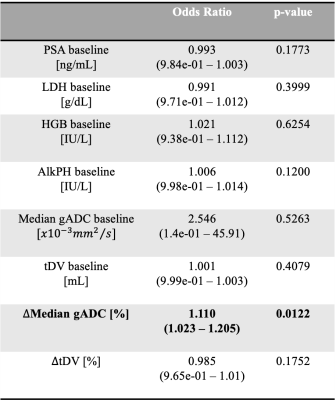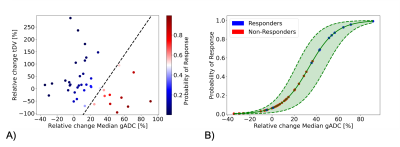Antonio Candito1, Matthew D Blackledge1, Fabio Zugni2, Richard Holbrey1, Sebastian Schäfer3, Matthew R Orton1, Ana Ribeiro4, Matthias Baumhauer3, Nina Tunariu1, and Dow-Mu Koh1
1The Institute of Cancer Research, London, United Kingdom, 2IEO, European Institute of Oncology IRCCS, Milan, Italy, 3Mint Medical, Heidelberg, Germany, 4The Royal Marsden NHS Foundation Trust, London, United Kingdom
1The Institute of Cancer Research, London, United Kingdom, 2IEO, European Institute of Oncology IRCCS, Milan, Italy, 3Mint Medical, Heidelberg, Germany, 4The Royal Marsden NHS Foundation Trust, London, United Kingdom
Developing a multi-parametric model of response in patients with metastatic bone disease based on biomarkers derived from Whole-Body Diffusion Weighted Imaging. A change in median ADC showed significance in identifying response. The model predicted response with an accuracy of 87%.

Table 1. Baseline characteristics for all the 41 patients. The blood-based biomarkers investigated were the Prostate-Specific Antigen (PSA), Hemoglobin level (HGB), Lactate dehydrogenase level (LDH) and Alkaline phosphatase level (AlkpH).

Figure 1. A) Probability of response derived from the trained logistic regression model which expects as features the relative change of Median gADC and tDV. B) Probability of response and 95% confidence interval (dashed lines) derived from fitting the logistic regression model input only the relative change of Median gADC. Estimates of the probability of response higher than 60% and lower than 40% showed low uncertainty. However, samples with a probability of response from 40 to 60% (and around the decision boundaries as showed in Figure 1A) shown higher uncertainty.
